Before there was the Fort Worth Star-Telegram, there was the Fort Worth Democrat. And before there was Amon Giles Carter, there was Buckley Burton Paddock.
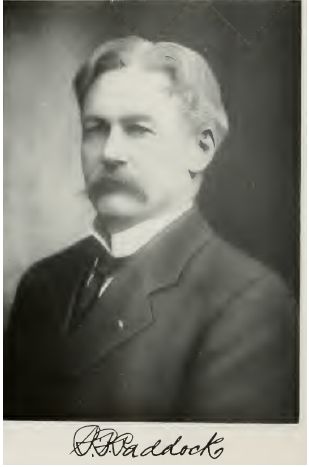 During the last quarter of the nineteenth century and into the twentieth century B. B. Paddock was Fort Worth’s biggest cheerleader. (Photo from Paddock’s four-volume history Fort Worth and the Texas Northwest.)
During the last quarter of the nineteenth century and into the twentieth century B. B. Paddock was Fort Worth’s biggest cheerleader. (Photo from Paddock’s four-volume history Fort Worth and the Texas Northwest.)
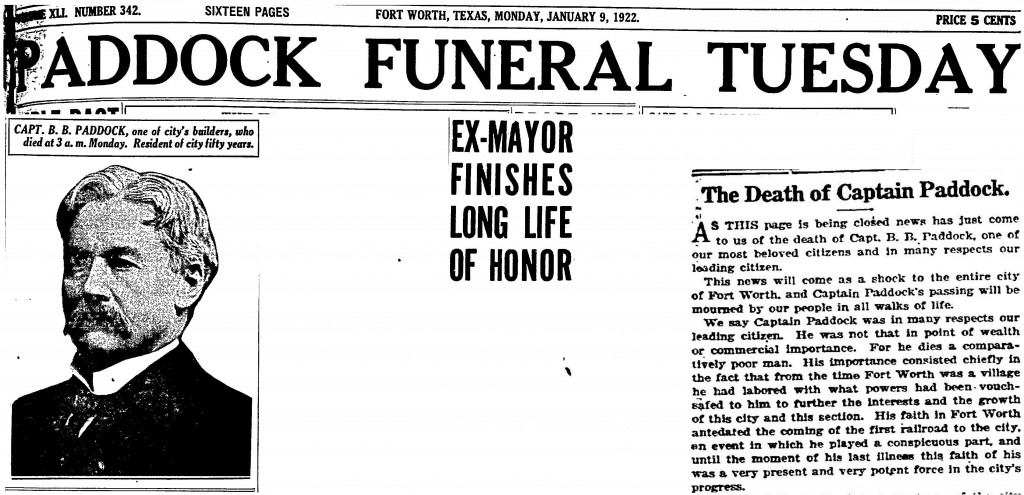 When he died on January 9, 1922—101 years ago today—he left behind a legacy of civic stewardship—a “long life of honor”—arguably as great as that of Carter or Ephraim Merrell Daggett, John Peter Smith, or Khleber Miller Van Zandt.
When he died on January 9, 1922—101 years ago today—he left behind a legacy of civic stewardship—a “long life of honor”—arguably as great as that of Carter or Ephraim Merrell Daggett, John Peter Smith, or Khleber Miller Van Zandt.
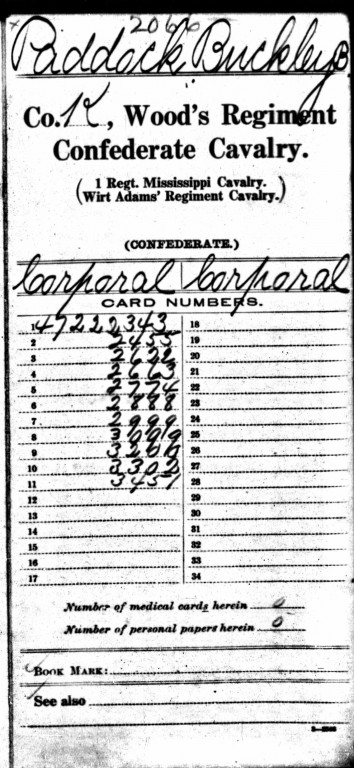 The Star-Telegram obituary said Paddock, born in Ohio in 1844, never attended a day of school, lived among Native Americans for a year, and, although a northerner by birth, enlisted at age eighteen in the Confederate army, where he served as a “secret service operative,” was captured seven times and escaped seven times. (In 1862 his father enlisted in the Union army at age fifty-four, was killed the next year at Vicksburg.)
The Star-Telegram obituary said Paddock, born in Ohio in 1844, never attended a day of school, lived among Native Americans for a year, and, although a northerner by birth, enlisted at age eighteen in the Confederate army, where he served as a “secret service operative,” was captured seven times and escaped seven times. (In 1862 his father enlisted in the Union army at age fifty-four, was killed the next year at Vicksburg.)
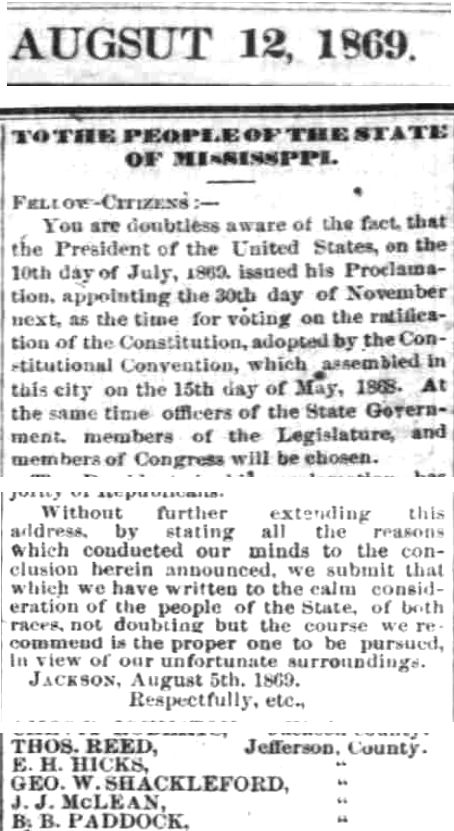 After the war B. B. Paddock read law and passed the bar exam in Mississippi. In 1869 he was in Jefferson County, Mississippi, where he was involved in state politics as voters debated the state’s Reconstruction-era Constitution. Clip is from the Jackson Clarion.
After the war B. B. Paddock read law and passed the bar exam in Mississippi. In 1869 he was in Jefferson County, Mississippi, where he was involved in state politics as voters debated the state’s Reconstruction-era Constitution. Clip is from the Jackson Clarion.
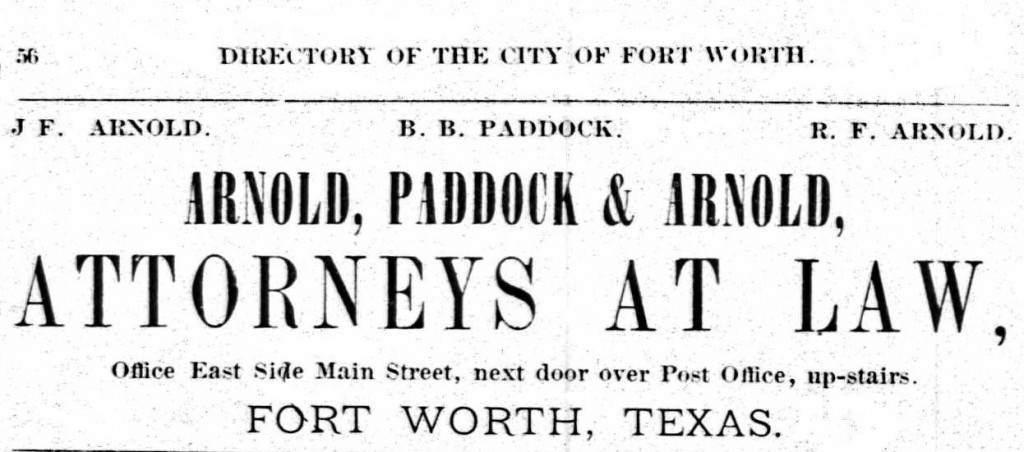 Paddock moved to Fort Worth in 1872 and joined a law firm. But he soon made the growth of the frontier city—not the practice of law—his life’s work. “I am the wealthiest man in Texas,” Paddock once said. “I have all the money that I want, and the glory of Fort Worth and west Texas is also mine because I am a citizen of both.” Ad is from the 1877 city directory.
Paddock moved to Fort Worth in 1872 and joined a law firm. But he soon made the growth of the frontier city—not the practice of law—his life’s work. “I am the wealthiest man in Texas,” Paddock once said. “I have all the money that I want, and the glory of Fort Worth and west Texas is also mine because I am a citizen of both.” Ad is from the 1877 city directory.
Paddock was a founder of the Fort Worth Board of Trade, two-term state representative, and four-term mayor. He was honorary president for life of the chamber of commerce, was ramrod of the Texas Spring Palace exhibition of 1889-1890. He helped to create Fort Worth’s fire department, water department, city parks, and school system. He worked to bring the packing plants to town. He edited a four-volume history of the region.
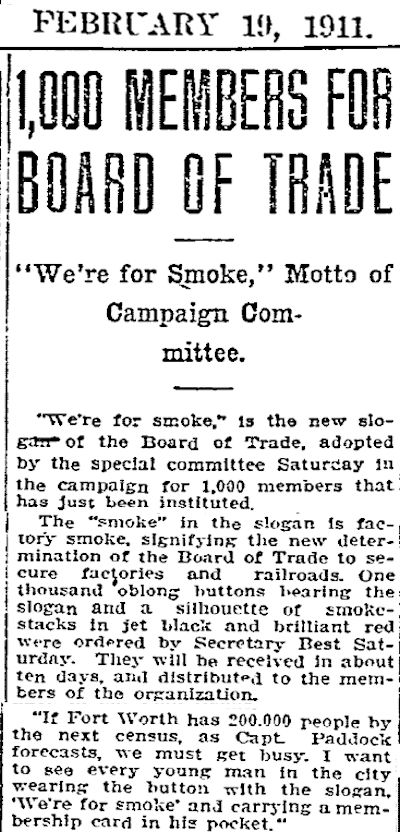 The “B. B.” in Paddock’s name could have stood for “Bigger (is) Better.” Paddock was a fervent champion of growth for Fort Worth. He was a member of the Board of Trade in 1911 when the board adopted the slogan “We’re for smoke” to reflect the city’s campaign to develop heavy industry and still more railroads. Note that Paddock had predicted that Fort Worth’s population in the 1920 census would be 200,000. (Fort Worth’s population in 1910 was 73,312, would be only 106,482 in 1920.)
The “B. B.” in Paddock’s name could have stood for “Bigger (is) Better.” Paddock was a fervent champion of growth for Fort Worth. He was a member of the Board of Trade in 1911 when the board adopted the slogan “We’re for smoke” to reflect the city’s campaign to develop heavy industry and still more railroads. Note that Paddock had predicted that Fort Worth’s population in the 1920 census would be 200,000. (Fort Worth’s population in 1910 was 73,312, would be only 106,482 in 1920.)
 But Paddock is best remembered as a newspaperman. In 1872, soon after moving to Fort Worth, he bought the Democrat.
But Paddock is best remembered as a newspaperman. In 1872, soon after moving to Fort Worth, he bought the Democrat.
 In 1882, when the Democrat became the Gazette, Paddock was managing editor. In his day the lines among editorial, news, and advertising content were blurred. With unabashed boosterism Paddock used the pages of his newspapers the way a cheerleader uses a megaphone. He assured Fort Worth’s residents that they could do anything they set their minds and muscles to. Reading his newspapers today, you get the feeling that Paddock could have coaxed the prickly pears and prairie dogs into doing “the wave.”
In 1882, when the Democrat became the Gazette, Paddock was managing editor. In his day the lines among editorial, news, and advertising content were blurred. With unabashed boosterism Paddock used the pages of his newspapers the way a cheerleader uses a megaphone. He assured Fort Worth’s residents that they could do anything they set their minds and muscles to. Reading his newspapers today, you get the feeling that Paddock could have coaxed the prickly pears and prairie dogs into doing “the wave.”
Fort Worth offered, he wrote, the best of both worlds: “the legally constituted society of the east and the free and untrammeled life of the west.”
Dallas newspapers teased Paddock about his Fort Worth boosterism, and through the pages of his newspapers, his voice was the loudest on this end of the Trinity River in the rivalry between Fort Worth and Dallas.
Paddock especially promoted Fort Worth as a railroad center with his “I think we can, I think we can” confidence in the town.
In 1873—three years before the first railroad arrived—Paddock drew the “tarantula” map—his vision of Fort Worth as a rail hub in the near future.
 In 1876, just days before the first train arrived, Paddock’s Daily Democrat introduced a double-duty nameplate atop its front page: First, the nameplate celebrated Fort Worth’s imminent coming of age with the arrival of the railroad. Second, the nameplate proudly displayed the “Where the Panther Laid Down” nickname that had been born in 1875 with a belittling yarn in the Dallas Daily Herald by Dallasite Robert Cowart. At the eight o’clock position on the circle can be seen a train, its engine billowing black smoke. At the six o’clock position can be seen a panther at rest.
In 1876, just days before the first train arrived, Paddock’s Daily Democrat introduced a double-duty nameplate atop its front page: First, the nameplate celebrated Fort Worth’s imminent coming of age with the arrival of the railroad. Second, the nameplate proudly displayed the “Where the Panther Laid Down” nickname that had been born in 1875 with a belittling yarn in the Dallas Daily Herald by Dallasite Robert Cowart. At the eight o’clock position on the circle can be seen a train, its engine billowing black smoke. At the six o’clock position can be seen a panther at rest.
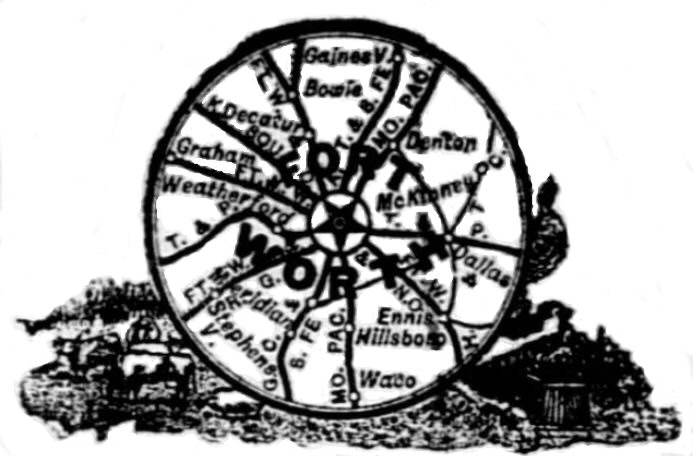 On January 11, 1887 a version of the tarantula map became the centerpiece of the Daily Gazette’s nameplate. Although some of the railroads shown in Paddock’s map never materialized, by 1900 Fort Worth would fulfill Paddock’s vision.
On January 11, 1887 a version of the tarantula map became the centerpiece of the Daily Gazette’s nameplate. Although some of the railroads shown in Paddock’s map never materialized, by 1900 Fort Worth would fulfill Paddock’s vision.
Paddock even served as president (1885-1889) of one of those railroads—the Fort Worth and Rio Grande.
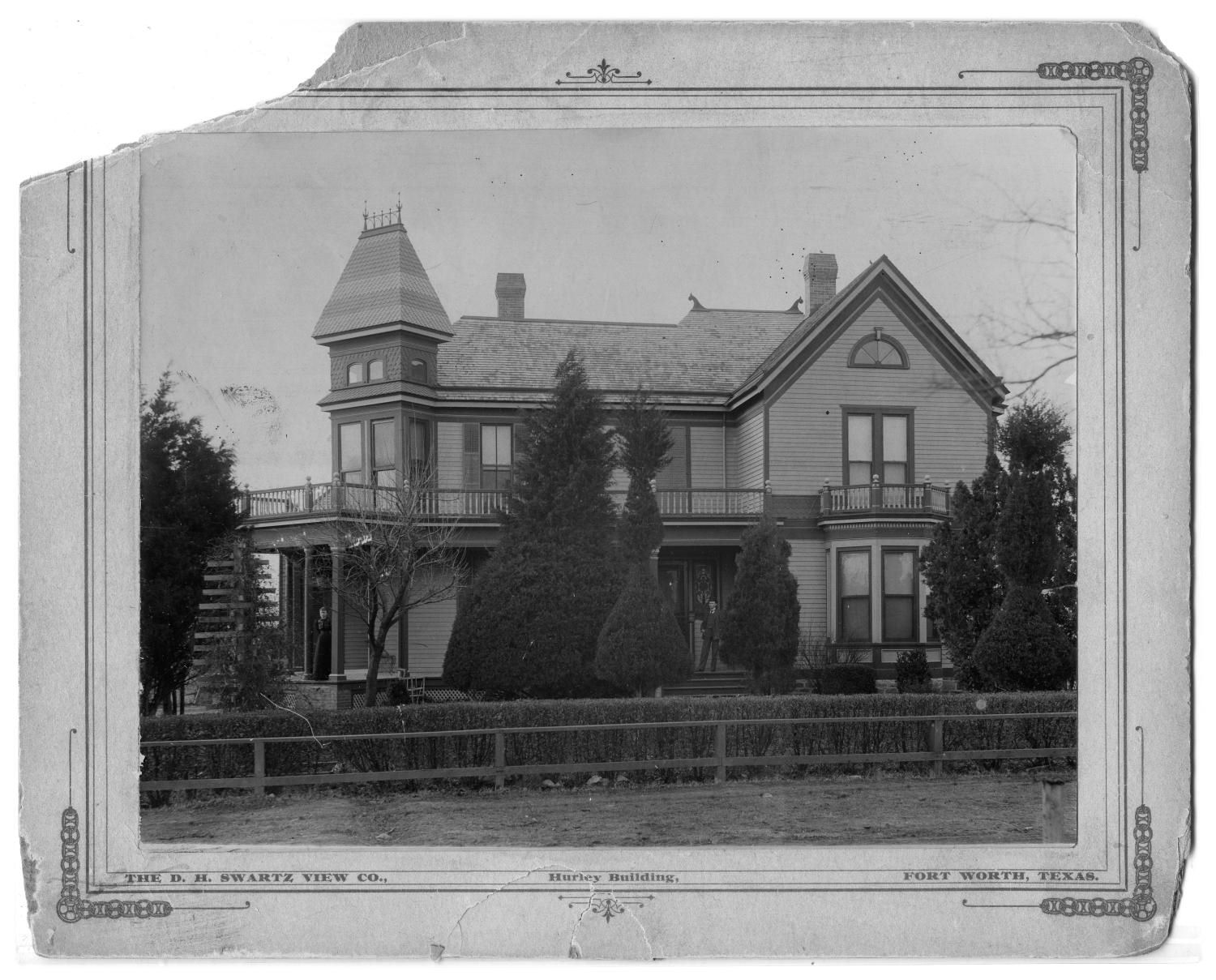 Edge Hill, Paddock’s house at Jennings and Terrell avenues, was built in the 1880s and demolished decades ago. When Paddock moved into the house in the 1870s, it was still outside the city limits. (D. H. Swartz photo from University of Texas at Arlington Library.)
Edge Hill, Paddock’s house at Jennings and Terrell avenues, was built in the 1880s and demolished decades ago. When Paddock moved into the house in the 1870s, it was still outside the city limits. (D. H. Swartz photo from University of Texas at Arlington Library.)
Paddock lived to see the North Main Street viaduct named for him.
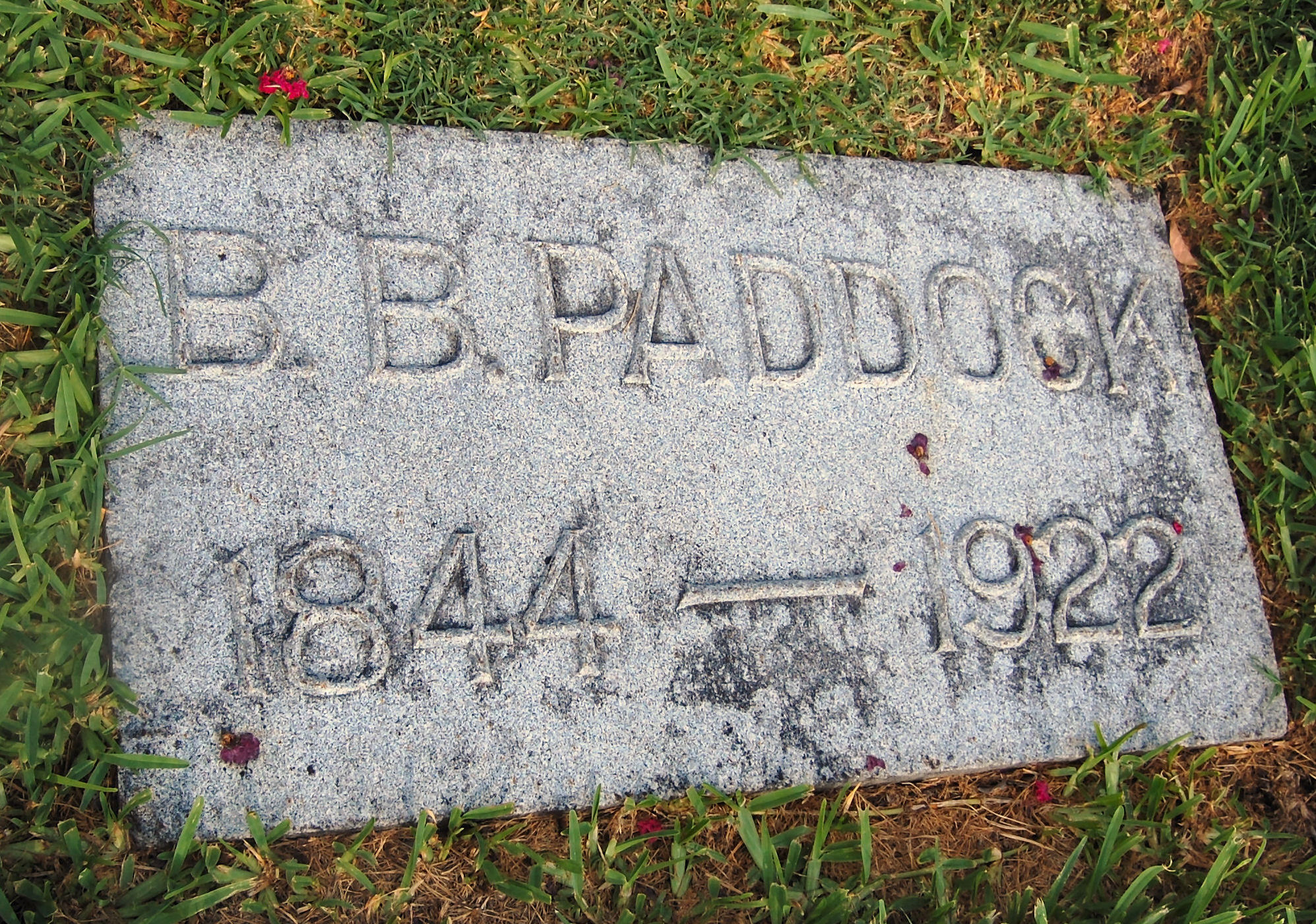 Buckley Burton Paddock is buried in Mount Olivet Cemetery under a headstone smaller than one of his own front pages.
Buckley Burton Paddock is buried in Mount Olivet Cemetery under a headstone smaller than one of his own front pages.
 On January 10, 1922 one of the pallbearers for Fort Worth’s first head cheerleader was Amon Giles Carter, the man who would hold the title for the next thirty-three years.
On January 10, 1922 one of the pallbearers for Fort Worth’s first head cheerleader was Amon Giles Carter, the man who would hold the title for the next thirty-three years.
The mantle—and the megaphone—had been passed.






Boardman Paddock, BB’s father, was my Great-great-grandfather. Apparently my father, Burton Manley Paddock was named after BB and I, Burton Michael Paddock Gregg, was named after my father and BB as well. Buckley Burton’s brother, Edward L. Paddock is buried at Forest Hill Cemetary near Owatonna, Steele County, Minnesota.
Mr. Gregg, I have studied Fort Worth history for years, and your namesake is the person from the past I would most want to meet.
After all of Paddock’s efforts to help “grow” Fort Worth, it does seem odd that his name hasn’t had more ofa presence.
I am so glad you let us know all about him.
What do you know about the “four volume history of the region” that he edited? Does it still exist?
Thanks for all of your research and sharing it!
Thanks, Donna. He was a remarkable person.
Here’s what I have found online in pdf format (been years, can’t remember websites; try this site):
History of Texas: Fort Worth and Texas Northwest Edition 4 volumes
A History of Central and Western Texas volume 1
Early Days in Fort Worth
History and Biographical Record of North and West Texas volume 2
Great article. A man who certainly should be recognized. I wonder if the man by the front door is Paddock and maybe his wife on the side porch?
Thanks, Jane. He is one of my favorite figures in Fort Worth history. I have magnified the house photo. Inconclusive as to ID of the two people.
Awesome story. He is (was?) my great-great grandfather.
Joshua, that’s some ancestor you got yourself! Of all the people in Fort Worth history, B. B. Paddock is the one I’d most want to be stuck in an elevator with. And that’s saying a lot. His name appears in 113 posts on this blog.
B.B was my cousin(several removed by this time) I lived all my life in Michigan and came to Texas 4 years ago. It was really interesting to find out about our connection to Texas. Quite a guy.
Of all the great figures in Fort Worth history, I think Paddock is the one I’d most want to meet.
My dad is really big into into my family genealogy. He said I’m related to this guy (his grandkids are my 5th cousins/3rd cousins twice removed).
And seeing you comment about him being a teller, I’m a direct descendant of the first Fort Worth bank owner (William McClanahan Harrison).
Mike, I have a photo of bank employees in 1885 where B.B. Paddock has signed his name and title of “Teller”. This seems odd to me since he arrived in 1872 and established himself quickly that he would be a teller in that year. Do you know anything about that?
Well, I’ll be. He’s listed as a teller in the 1885 city directory, too. But by then, as you know, he had been a civic leader and newspaper editor for years. He was living in that big house on Jennings at Terrell. He had been a state senator by then! In 1885 he was president of the Fort Worth & Rio Grande railroad! Usually civic leaders by his stage of life were directors of banks. The title “cashier” back then could refer to a bank officer, but as far as I know a teller was . . . just a teller. In seven years that teller would be mayor! It’s a mystery to me.
It would be nice if the city would put a sign on the bridge with his name. I never knew that the old bridge was 1) so old 2) it had a name
What a shame, who might support an effort to label the bridge?
Yeah, the plaque on the sidewalk is readable only by pedestrians. But a small plaque (giving the year, architect, builder, city or county officials at the time) is the only marker on most of our bridges, including the “new” West 7th Street bridge, which technically is the Van Zandt viaduct.
Really, why aren’t there more things named after B.B. Paddock? So much named after Amon Carter and these days, you don’t even have to be dead to have a school or a street or a tollway named after you. I had never heard of him before… Thanks for spotlighting a really interesting FW character!
Good question. No street (except maybe in Keller), no park, no school. On the other hand, the viaduct is a mighty fine slab of concrete to have one’s name on. I guess it’s not fair or even accurate to compare the two men, although both were cheerleaders who used their newspaper as a megaphone to cheer on Fort Worth (and to fuss with Dallas). Paddock did not have the wealth or national clout of Carter. TCU’s Amon Carter Stadium was named for Carter because he helped fund its construction. And Carter lives on in his foundation, which funded Amon Carter Museum, the Water Gardens, etc.